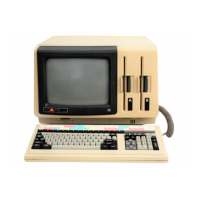Basic
I/O
System (BIOS) Functions
Two
CP/M-86
utilities use the IOBYTE:
•
PIP
allows access
to
the physical devices;
•
ST
A T allows logical-physical assignments
to
be
made
and
displayed.
Table 5-3
IOBYTE Field Defintions
CONSOLE
field (bits 0,
1)
o -console
is
assigned to the console
printer
(TTY:)
I - console
is
assigned
to
the
CRT
device (CRT:)
2 -
batch
mode; use the
READER
as the
CONSOLE
input,
and
the
LIST
device as the
CONSOLE
output
(BAT:)
3 - user-defined console device (UCI:)
READER
field (bits 2, 3)
0-
READER
is
the Teletype device (TTY:)
1 -
READER
is
the high-speed reader device (RDR:)
2 - user-defined reader # 1
(UR
1:)
3 - user-defined reader #2 (UR2:)
PUNCH
field (bits 4, 5)
0-
PUNCH
is
the Teletype device (TTY:)
1 -
PUNCH
is
the high speed
punch
device (PUN:)
2 - user-defined
punch
# 1
(UP
1:)
3 - user-defined
punch
#2 (UP2:)
LIST
field (bits 6, 7)
0-
LIST
is the Teletype device (TTY:)
1 -
LIST
is
the
CRT
device (CRT:)
2 -
LIST
is
the line
printer
device (LPT:)
3 - user-defined list device (UL1:)
NOTE
The
implementation
of
the
IOBYTE
is
not
fully
supported
by the
NEC
BIOS.
IOBYTE
has been implemented
on
the
APC
only
for
assigning the
LIST
device
to
either LPT:
or
UL1: as follows.
LPT: = Parallel centronix interface
UL
1:
= Serial RS 232C interface
(standard
on
APC)
5-9

